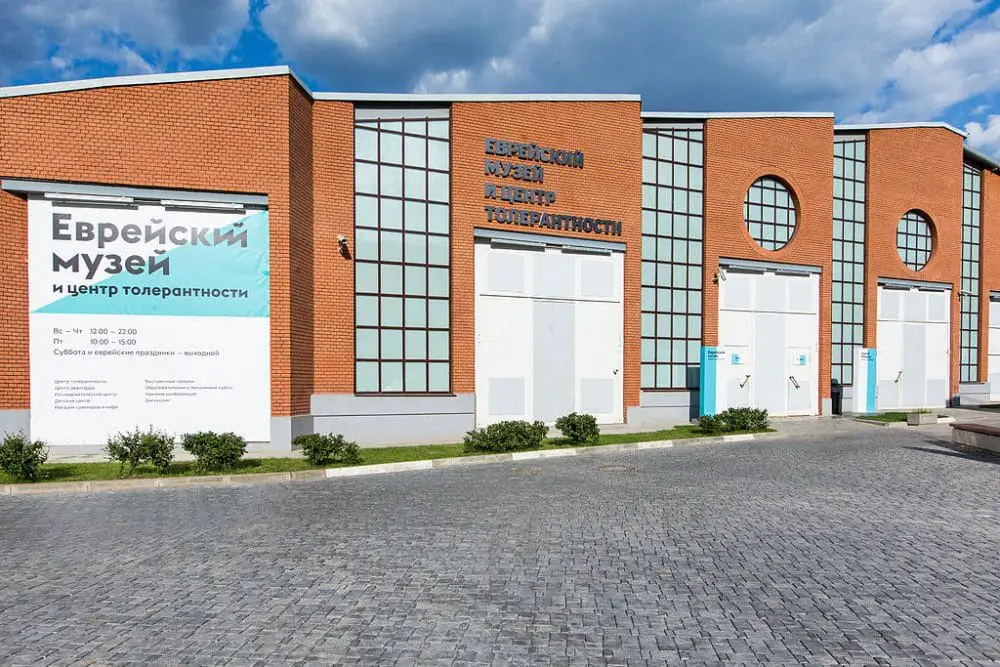“What should I see in Moscow?” is a question we hear often – and one that entirely depends on your interests. Moscow is vast with an astonishing number of museums and galleries. The guide below lists a few of the major museums and galleries based on what the interest they would appeal to. See our other guides for Theaters, cafes, shopping, and more.
Seeing museums in Moscow can be a very inexpensive and enjoyable way to see the city. Student IDs are accepted for student discounts in most museums and many Moscow museums are open for free on the third Sunday of every month. This site gives a full listing (in Russian) of those museums participating. If you are in Moscow in mid-May, there is also an annual Night at the Museums, where museums stay open late, offer tours, masterclasses, and more.
1. Guide Companies and Tours
Bridge to Moscow offers professional English-speaking guides and regularly scheduled group tours of museums, areas around Moscow, and even guided trips outside of Moscow. Follow these via thier Facebook page.
Patriarchy Dom is another English-speaking tour company in Moscow offering group tours. These are generally scheduled a month or two in advance and listed on their site.
Moscow Through an Engineer’s Eyes works only in Russian, but does some fascinating tours of architecture, factories, infrastructure, neighborhoods and more, focusing on how these things were built and how they work.
2. Art

The State Tretyakov Gallery
Lavrushinsky per., 10; M. Tretyakovskaya
Moscow’s largest and most famous art museum started when Pavel Tretyakov, a successful entrepreneur and industrialist, gave his massive art collection and one of his private residences to the state. The two combined to make the Tretyakov Gallery in 1893. Today, the expanding facility displays art ranging from ancient icons to portraits of Russian nobility to modern art by Kandinsky and Malevich.
The Pushkin Museum of Fine Arts
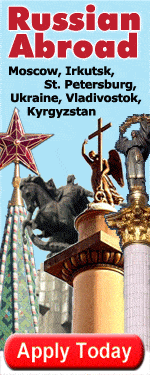
Originally founded in the early 1900s, this museum now features replica Egyptian and Greek art in addition to a good collection that ranges from ancient Russian art Chagall and Picasso. Still open, this museum is current in the midst of a multi-year, multi-million-dollar expansion project that will eventually turn it into a “museum-city,” with multiple buildings connected by an underground level of shops, cafes, and tunnels.
The Andrei Rublev Museum of Early Russian Culture and Art
Andronyevskaya Square, 10; M. Ploshchad Ilyicha
On display are the icons of Moscow’s school of the 15th to 16th centuries, sculptures of the 12th–17th centuries, and copies of frescoes. An affiliate of the museum is located at the Church of the Intercession (ul. Novozavodskaya, 6; M. Fili; Tel: 148-4552) which displays the icons of the end of the 17th century painted by the Tsar’s craftsmen.
A. Art Complexes (Urban Revitalization)
WinZavod
4th Syromytnicheskii Pereulok, 1, building 6
This former wine factory is now an artistic community center hosting some of Moscow’s most cutting-edge art as well as film showings, concerts, art lessons, and the largest crowds of Muscovite-bohemians to be found anywhere.
Red October
Bersenevskaya Embankment, 6
This former chocolate factory is now a complex of trendy bars and cafes, galleries and show rooms, designer and consignment clothes shops and more. Nothing here is cheap, but everything is cool.
Flacon Design Factory
Bolshaya Novodmitrovskaya ulitsa, 36 строение 2
Flacon opened in 2009 on the site of a former glass factory in central Moscow. It calls its a “creative cluster” and hosts festivals, workshops, and several shops for the creatively-minded.
ArtPlay
10 Nizhnyaya Syromyatnicheskaya St.,
A former tea factory was taken over by a bunch of artists and today ArtPlay is filled with galleries, shops, cafes, and trendy restored brick. They offer a regular schedule of workshops and events.
B. Contemporary Art
Garage Museum of Contemporary Art
9/32 Krimsky Val St.; Inside Gorky Park
Garage was founded in 2008 and moved into its new, ultra-modern facilities inside Gorky Park in 2015. The center displays a wide array of art, but also acts as a cultural center with workshops, talks, movies, and events. Garage is one of the brightest focal points in modern and contemporary art culture in Moscow today.
The following galleries are considered to be the most prestigious show rooms in Moscow among today’s Russian artists (list contributed by E. Varshavskaya)
3. Military
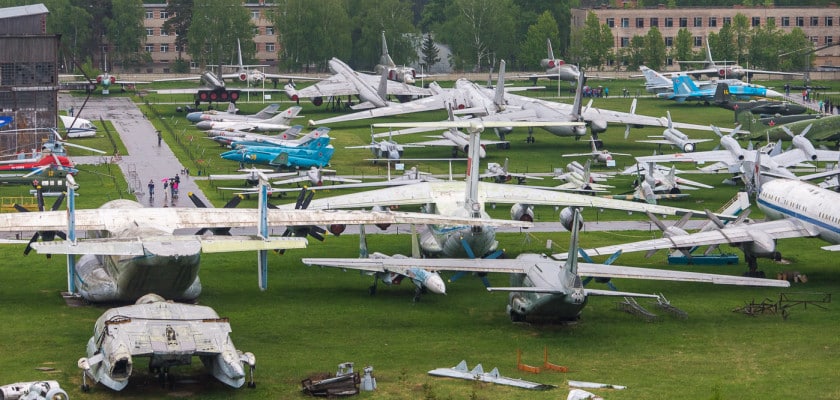
Central Armed Forces Museum
Sovietskoy Armii ul., 2; M. Novoslobodskaya
Formerly the Museum of the Red Army, this museum is mostly devoted to WWII – you can see the eagles from the Reichstag rooftop taken by the Soviets on display here. Most of the displays have only Russian-language captions, but you can get a printed guide with English translation for each battle hall pretty inexpensively. The main attraction, however, is at the end, when you walk into the back courtyard and a massive outdoor collection of actual military equipment ranging from jets to tanks to rocket launchers.
Victory Park and the Museum to the Great Patriotic War
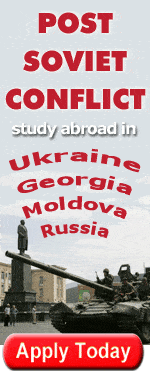
Construction on this complex actually began just before WWII ended. The museum is a massive collection of arms, uniforms, propaganda, and social history pieces from the war, and some interesting tributes to Stalin. Unfortunately, all information is in Russian, so you may need a guide. The surrounding park is meant to augment the museum – and emphasizes the unity of the Soviet people (interestingly by including a small synagogue, mosque, and an Orthodox church) as well the unity of the Allies (featuring a statue with American, Soviet, French, and British soldiers standing together. The park makes for interesting stroll (or rollerblading – bring your own skates) and on summer weekends you can play “count the brides” due to the Russian tradition of visiting war memorials on your wedding day.
Battle of Borodino Museum Panorama
Kutuzovskyi prospekt, 38; M. Park Pobedii
Gives a few exhibitions and a very interesting 3-D panorama of the battle that turned the war with Napoleon, which is viewed with sound effects and narration playing over loudspeakers.
Museum of the Lend-Lease Program
Zhitnaya Ul., 8; M. Oktyabrskaya
A small group of Russians organized this tiny museum in a public school as part of the 60th anniversary of the end of WWII. The thing that makes it interesting is that the Land-Lease Program, hailed by western history textbooks as major contributor to that victory, is understated (if mentioned at all) in the Russian. This museum is one-of-a-kind here. Because the museum is inside a school, you need to call ahead to secure a pass to get inside: 8 916 510 50 87.
3. History
The State Gulag Museum
16 Petrovka ul; M. Kuznetsky Most
Run by a Gulag survivor, this interactive museum tries to take you inside the Gulag with sound, sight, film, and more.
The Museum of Modern History
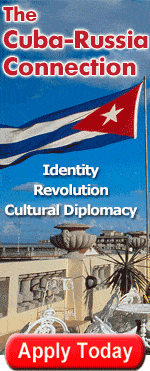
This is one of the world’s biggest museums of modern history. The museum covers mostly social history running for the hundred and fifty years or so spanning the decline of Romanov rule, the years of Soviet rule, and the transition to modern Russia.
Kremlin Armory
M. Biblioteka Lenina, Aleksandrovsky Sad
Definitely worth a visit and be sure to bring your student card for a significant discount. This museum focuses on the grandeur of Tsarist times and features everything from medieval weaponry to tsarist carriages. There are always tons of tour groups, so you can listen in on several different guides, if you don’t want to pay for one yourself.
Diamond Fund
M. Biblioteka Lenina, Aleksandrovsky Sad
A collection of precious stones and Russian jewelry, as well as gold and platinum nuggets, and Tsarist-era opulence is displayed.
State Historical Museum
Red Square, ½; M. Okhotny Ryad
A general collection of exhibitions from ancient to modern times in Russia with an especial emphasis on pre-history.
Lenin’s Mausoleum
Red Square
Lenin is still considered a must-see, even if seeing him is a bit morbid. The mausoleum is only open from 10-1 every day except Friday, Sunday, and Monday – so scheduling him in can be difficult. When you come, come light – any larger bag or camera that doesn’t fit comfortably in your pocket will need to be checked – which can double your time in line. Lenin also closes at least once year – at which time he’s taken back to the lab to have his fluids flushed and make up refreshed. Interestingly, the lab that maintains him has patented several medical advances – such as ways to keep capillaries open – discovered in their efforts to keep Lenin preserved.
4. Everyday and Unexpected
The Metro
You can now take a self-guided tour of Moscow’s beautiful metro by picking up an audio guide inside Metro Komsomolskaya or Park Kultury (both on the Brown Line – look for the stands just inside the building). Some of Moscow’s most beautiful art and architecture is underground! Also don’t miss The Metro Museum.
Museum of Soviet Arcade Machines

Here you can see about 30-40 fully-restored, Soviet-era arcade games – all those on display are in full working order and you can even play some of them. Run by enthusiasts, this museum has now upgraded its premises twice in Moscow and opened an affiliate in St. Petersburg. Admission will run you just over $10, but include 15 tokens to play the games on display!
Novodevichy Cemetary
M. Sportivnaya – Exit Metro and turn right. Walk until you see the monastery. The cemetery is at the back.
Here lies Gogol, Shostakovich, Kruschev, Tupolov, Mayakovsky, Chekov, Bulgakov, and many, many others amongst impressive headstones. Exit Metro Sportivnaya and turn right along Luzhnetsky prospect. Walk until you get to Novodevichy Convent, turn left and follow the wall until you get to the cemetery. You will be charged a small admission and can (recommended) buy a map of the famous graves.
Moscow Zoo
B. Gruzinskaya, 1; M. Krasnopresnenskaya
The zoo has now been completely remodeled and is again wildly popular with locals.
5. Museum Estates
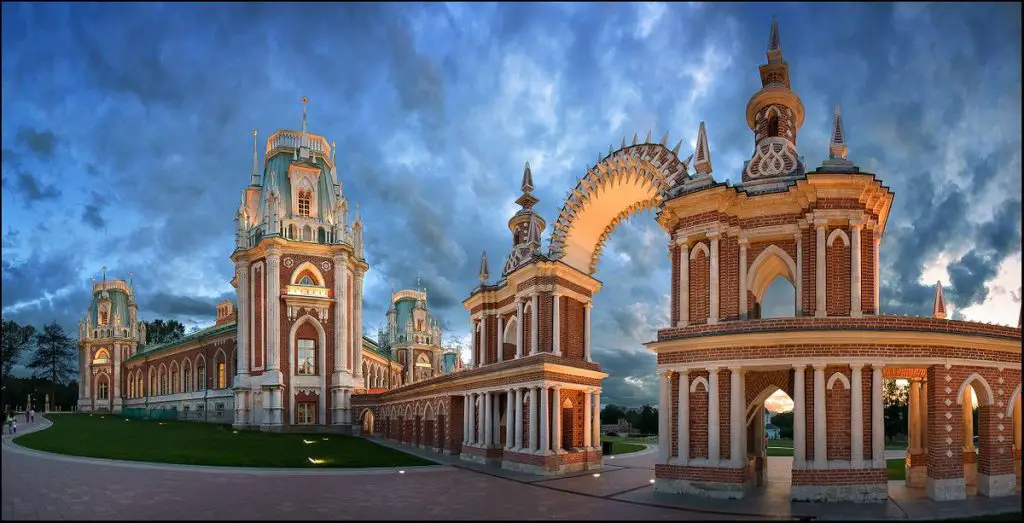
Kolomenskoye Museum-Preserve
Andropov Avenue, 39; M. Kolomenskaya
This architectural and historical preserve built in the 16th-17th centuries used to be a village residence of the Russian Tsars (Peter the Great spent his early years here – you can see one of his old houses). The museum is famous as an outstanding example of 16th-century tent-roof architecture, as the home of The Church of the Ascension (1530-1532) and for interesting samples of the Russian wooden architecture brought here from different regions of Russia. This is also the location of a yearly “Honey Festival” and one of the main sites for some of Moscow’s many Maslenitsa celebrations.
The Tsaritsyno Museum
Dolskaya Street, 1, M. Orekhovo, Tsaritsyno
The palaces here were begun but never finished by Catherine the Great in the 18th Century. After her death, the half-finished structures laid in ruin until being restored and turned into a museum in 2007. Today, the main building is a museum (focusing on art and history), while the surrounding grounds are often used for concerts and strolling through acres of decorative bridges and grottos. You can also see some of the area’s ancient history: Kurgan burial mounds preserved from from the 11-13th centuries.
The Kuskovo Estate
Yunosti ul., 2; Metro Kuzmenki
The Kuskovo Estate is one of the most beautiful palace and park ensembles in Moscow. The estate and the lands around it belonged to Count Sheremetev at the beginning of the 17th century.
The Palace-Museum of Serf Art in Ostankino
1st Ostankinskaya Street, 5; M. VDNKh
(Currently Closed for Reconstruction) This is a brilliant monument representing the classic architectural style of the 18th century, as well as to once common-practice of serf theaters (rich counts kept serfs as professional actors, scene builders, etc., when the serfs were freed, these “kept” actors turned professional and helped found Russian Theater practices).
6. Literature, Theater, and Music
State Central Theater Museum
Ul. Bakhmshin; M Paveletskaya
This is one of Russia’s largest repositories of exhibitions and materials on Theater history. They host seminars on Theater history occasionally and other events.
The House-Museums
Russia has many preserved apartments and houses that have been turned into museums for their former residents. These sometimes host special performances, concerts, and lectures. You can find these in Moscow for such greats of Russian culture as:
- A. Pushkin
(Old Arbat, 53 M. Arbatskaya). - K. Stanislavski
(Leontyevsky Pereulok 6) - A. Chekov
(Ul. Sadovaya-Kudrinskaya 6) - L. Tolstoy
(Ul. L. Tolstoy, 21) - V. Mayakovsky
(Lybyansky Proyezd 3/6; Currently Closed for Reconstruction) - M. Bulgakov
(10, Ul Bolshaya Sadovaya; near Patriarch’s pond!) - F. Shalyapin
(Novinskii bulvar, 25) - P. Tchaikovsky
(Kudrinskaya Sq., 46/54) - A. Scriabin
(Ul. Vakhtangov, 11) - M. Glinka
(Ul. Fadeyev, 4)
7. Religious
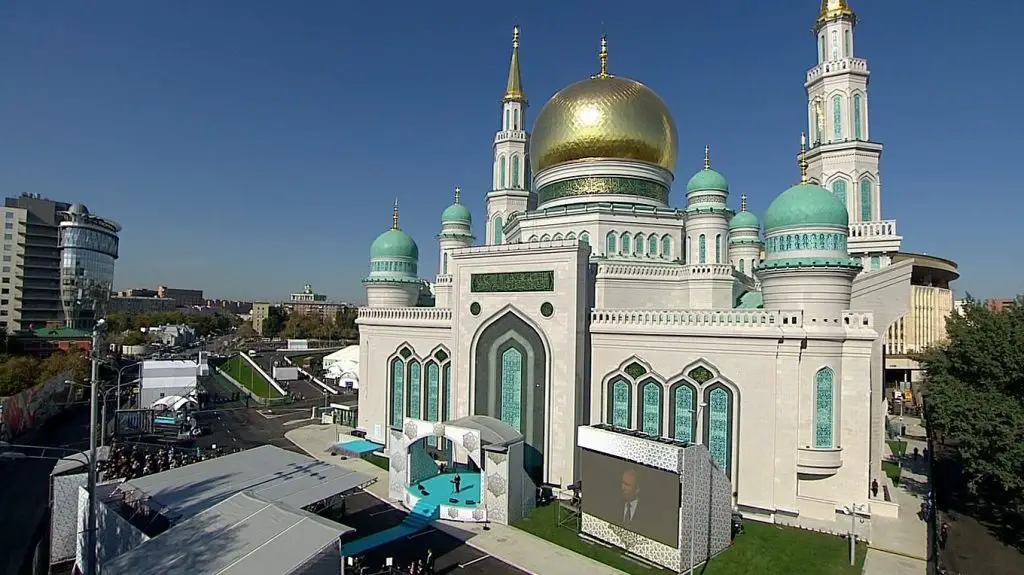
Ulitsa Danilovskiy Val, 22; M. Tulskaya
Originally founded in 13th century, this monastery has seen a lot of Russian history and seen its own destruction and renovation several times. In 1983, it became the official residence of the Russian Patriarch and headquarters of the Russian Orthodox Church. Today, it is one of the best preserved functioning monasteries in Russia – and open to the public.
Museum of Tolerance
Ulitsa Obraztsova, 11, стр.1
Not far from the Moscow Jewish Community Center is one of the largest Jewish museums in the world. The Museum of Tolerance hosts lectures and events on tolerance and also gives a wide history of Russia from a Jewish perspective – with a particular focus on shtetl life and Jewish contributions to Russia’s arts and to the war effort during WWII. For more Jewish sites, see our Guide to Jewish Moscow.
Cathedral Mosque
Vypolzov per., 7
Moscow is home to one of Europe’s largest mosques. They offer regular tours that showcase the history and architecture of the magnificent exterior and interior of the building as well as introduce you to the basic of tenants of Islam. Tours are available in both English and Russian.
Christ the Savior
Ul. Volkhonka, 15
This is the center of Russian Orthodoxy – where Christmas Mass is held, led by the Russian Patriarch, and where new Patriarchs are coronated. Originally built under the last Russian Tsar, the building was blown up by the Soviets – but reconstructed using the original blueprints after the fall of Communism. It is free and open to the public.
Novodevichy Convent
As you leave M. Sportivnaya, turn right and follow Luzhnetsky prospect till you get to the big convent wall. Originally founded in the early 16th century, much of the monastery has remained intact and most has been restored in recent years. This is a working nunnery and offers services (which include a fantastic women’s choir). See the cemetery connected with it for a who’s who of Russian historical figures from Chekhov to Yeltsin.
8. Science and Technology
Memorial Museums of Astronautics
Prospekt Mira, 111; M. VDNKh
Founded by the Soviets to showcase Soviet space achievements, this museum is located in the base of a giant monument to a rocket taking flight inside to VDNKh, a large exhibition complex in Moscow that has now been restored and is worth a visit on its own.
Experimentarium
Leningradskii prospekt d.80, k.11, M. Sokol
This is a very fun hands-on, interactive science museum. It’s designed for kids – but popular with everyone.
Darwin Museum
57/1 Vavilova st.; M. Akademicheskaya
One of Moscow’s best science museums. This takes you through ecosystems and evolution with lots of big, colorful exhibits.
Moscow State University Museum of the Earth (Geology)
Inside the Main MSU building at Sparrow Hills; M. Universitet
Vernadsky Geological Museum
ul. Mokhovaya, 11, k. 2
Moscow’s oldest museum!
Paleontology Museum
Profsouznaya St., 123
Whether you loved dinos or mammoths as a kid or are really into paleontology, you will certainly enjoy a visit to this well-designed museum. Ask about any courses or seminars. Many of them are mainly for kids, but it might be good language practice anyway.
Ostanikino
M. Shabolovskaya
This television tower is the largest built under the Soviets. There is a viewing platform at the top.
Botanical Gardens
26 Prospekt Mira; M. Prospekt Mira; Tel: 280-6765


